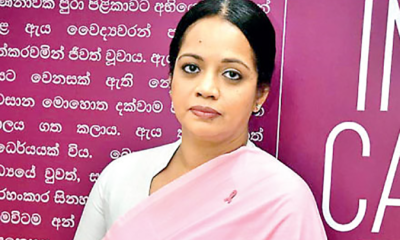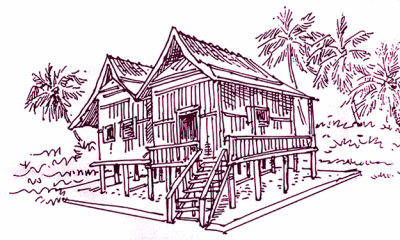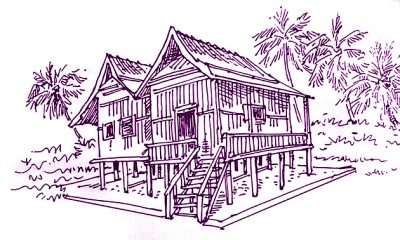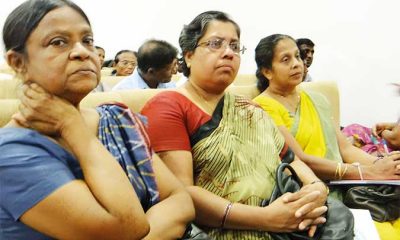Features
Recalling the glorious Caribbean
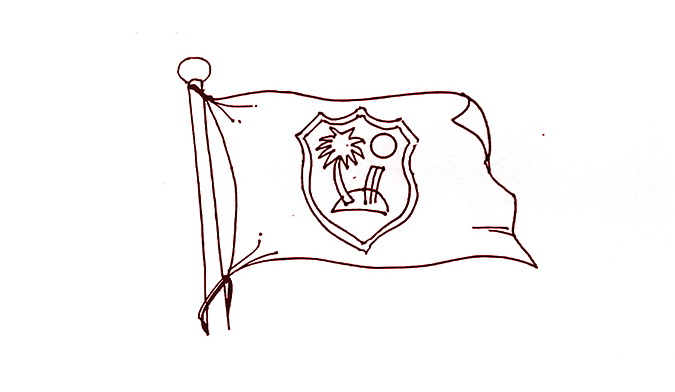
Excerpted from Memories that linger: My journey through the world of disability
by Padmani Mendis
I have visited the islands of the Caribbean on many occasions primarily to introduce Community Based Rehabilitation (CBR) and for field evaluations carried out in St. Lucia and Jamaica. On other occasions, to introduce the concept and the strategy to decision makers – as in Barbados, Grenada and the Bahamas. These islands in the Caribbean were perhaps best known to us in Sri Lanka as the West Indies. The song sung by Harry Belafonte had of course made one of them, namely Jamaica, known the world over as his “Island In The Sun“.
The West Indies, one might say, was like India, a creation of the British as an approach in granting independence. In India, the British brought together princely states to form one country and in spite of the vastness, succeeded. But with these small islands, the same tactic failed. Within a few years each of the 10 countries that formed the federation became independent. The name West Indies however stuck and the countries share some things in common – like their cricket team. This has not changed, and we still know them best for their skills in the game of cricket as well as for their enjoyment of the game.
They had perhaps, inherited their interest in cricket through their link with the British, having been conquered by those colonials and then, like us, been part of the great British Empire. I cannot say however that the skill and the enjoyment of the game of cricket were inherited from the British.
The skill looks inborn and the enjoyment inherent. Both were of a singularly and uniquely Caribbean nature. No international player can match the cricket played by Walcott, Weekes and Worrell, or more recently by Brian Lara at the wicket. No bowler has yet come on par with “those two little pals of mine, Ramadhin and Valentine”.
I first went to the West Indies with this cricket calypso ringing in my years:
Cricket luvverly Cricket,
At Lord’s where I saw it;
Yardley tried his best,
But Godard won the test,
With those two little pals of mine,
Ramadhin and Valentine
.‘Lord Beginner’ 1950
The people of the West Indies had their own style of music and of dance. And they broke into song and dance at the slightest provocation, as it were. Both descending no doubt from their mixed African and Spanish heritage.
For the people of the Caribbean were of an exceptionally mixed race. I saw this at once when I first met them. Their skin was of all hues of brown, black and white – and sometimes the white face even had that pink tint in it. Their hair similarly ranged from being frizzled to straight and all waves of in between. But one feature I missed – I never saw any native blondes, or red heads for that matter. They varied in body-build from the African to the Caucasian.
I recall the first time I walked into a bank in Barbados. It was new and spotlessly clean. With a distinct air of discipline about it. The radio was on and it was playing – calypso music of course. And to that infectious rhythm, the staff all dressed alike in light and dark shades of blue, each in their seats and focused on their work, were moving smoothly to the rhythm of it. It mattered not whether it was unconsciously or subconsciously. It was just such a delightful scene.
Jamaica
On my first visit to Jamaica I was surprised to meet an old friend, Marjorie Forrester, Director of the School of Physiotherapy.
I was happy to meet Marjorie on this first brief visit to Jamaica. She and I had come to know each other in London. We had followed together the Two-year Diploma Course in the Teaching of Physiotherapy some 20 years earlier. While I was at Guy’s Hospital in London, she was in Nottingham. But we met during our four semesters at the Polytechnic of North London and had become friends. Even on this visit, she invited me to her home so I could meet her husband Huntley. He was a very active leader in the Disability Movement in the Caribbean, and one who was full of fun with many jokes he shared generously.
I was a frequent visitor to their home on subsequent visits to Jamaica. In her home Marjorie arranged for me to meet many friends of Huntley’s, all with experience of disability. So we enjoyed healthy discussion and debate. And they needed some persuasion to accept CBR. But persuaded they were.
But one evening at Marjorie’s turned out to be rather embarrassing. Marjorie wanted me to meet someone who was doing some work also in disability and also as a Consultant for the WHO. She was from Canada. She specialised in sexual concerns in people who had paraplegia and other such paralyses.
She was very much against the idea of CBR which she believed to be giving a very poor quality of rehabilitation to poor people in poor countries. She challenged me with this her belief. And I was foolish enough to take her on. An unnecessarily heated argument ensued for which I later apologised profusely to Marjorie and Huntley. But what was done was done. Defending CBR was not new to me. But getting so worked up about it was. I knew I should have had better control of myself.
But worse was to come, as Marjorie informed me later. Marjorie had driven her to the airport the next day. On the way she wanted Marjorie to stop at the General Hospital in Kingston. There she went to the Physiotherapy Department, called all the therapists together and asked them to look out. She warned them that Padmani Mendis had come with some low-quality care and they would all soon be out of a job.
As I said earlier, criticisms by specialised professionals was not new. I did face this occasionally. I was happy when soon, as a profession, they would accept CBR when their global professional body, the World Confederation of Physical Therapy, stopped resisting, and finally did recognise it.
Where to Stay in Lucea, Jamaica
After introducing the project in St. Lucia, I realised that CBR development in so many islands of the West Indies would need guidance and support from someone like me for quite some time. I suggested to Dr. Hindley-Smith and Dr. Harold Drayton that it may be prudent to find me a counterpart from within the region rather than get me down each time from far away Sri Lanka. It should be a professional who could work with me when I went next to Jamaica. She or he should have the capacity to continue the tasks that I was presently doing.
So when I went to Jamaica the second time, I was joined by Geraldine Maison, later Maison-Halls. She was a physiotherapist and one with a charming personality. We got on famously with each other and were of immense mutual help. Geraldine thereafter did work in CBR for many years, both as a staff member of WHO, Geneva and in her own country, Guyana.
When we went to Lucea in Jamaica the question was where we would stay. We could have found a home prepared to keep us as paying guests in this small town. But no, someone from the health centre had a better suggestion, “How about Miss Katie?” We were told that Miss Katie was an elderly Jamaican who lived on her sugar plantation. A message was sent to Miss Katie to ask if she would have us. Geraldine and I moved in with Miss Katie that evening.
Miss Katie’s sugar plantation was not an active one. It was not profitable to grow sugar any more, she told us later. The sugar land was overgrown and was taken over by masses of grass. The uneven dirt roadway was just about clear enough for us to drive through. Then suddenly we came upon this caricature-like two-storied wooden house, appearing to be almost as if it were crumbling from age. And in this we found Miss Katie – a warm, generous and motherly “old lady”.
I had to use those words “old lady”. The word “elderly” was too cold to describe Miss Katie’s warmth – a warmth that oozed through her every pore. And her majesty. This small-made lady on the verge of bending in two – majesty, no other word but that.
And so Geraldine and I had a wonderful stay in Lucea. It was a 20-mile drive each way from our work but what was that? I will tell you more about it soon. Miss Katie had not known any guests for quite some time. She derived so much pleasure from just fussing over us and feeding us. In her garden Miss Katie had a chillie plant bearing green chillies that soon turned red. Every evening by my dinner plate I would find on a little silver tray one of her precious home-grown chillies. She knew that coming from Sri Lanka I appreciated that added taste in my food.
A car to drive
When I was at the WHO office on my first day in Kingston, a logistical problem that was difficult to solve was my transport. It was clear that the WHO had to provide me with a chauffeur-driven vehicle to take me to Lucea and back, a distance of over 200 miles taking over four hours of driving. And the chauffeur had to stay on to drive me around Lucea too. I waived immediately the requirement of a chauffeur. I could drive myself. But I did require a car.
Listening in to the discussion was a professional from Denmark employed on a WHO project in Jamaica. He had just been given for his use a new Toyota saloon purchased by his project. We had conversed previously and I had told him about my experience working as a physiotherapist in Denmark and how much I had enjoyed it. With that, we had accepted each other. We would not meet again because he was going away the next day and was not expected back for two months.
After much discussion and even then with a great deal of reluctance, the young man from Denmark had no choice but to offer me the use of his brand-new vehicle for the duration of my stay. But he laid down a condition. The vehicle could only be driven by me. I had to make a solemn promise that I would not let anyone else drive this precious thing. It was an easy promise to make, because I could not see any reason to have to break it.
So in this little beauty, Geraldine and I drove between Kingston and Lucea when we had to. And 20 miles there and back from Miss Katie daily. The 20-mile stretch was a winding beach road. The beach was made of a continuity of little coves and the scenery from the road was too beautiful to describe in words. Although we had beautiful beaches back in my own country all round our coastline, these were different.
These coves made the coastline small and intimate. Ours was a smooth coastline with wide, sandy beaches. Geraldine and I kept our sea-bathing attire in the car. And every evening after work we would stop by a different cove and stay in its calm sea until dusk had almost fallen. Then home to Miss Katie. This was indeed the life.
Problems with the Car
Our peaceful life was disturbed by two incidents with the car. One day while we were travelling along a narrow stretch of road, I came too close to another car. The wing mirror on Geraldine’s side was smashed to pieces. My thoughts flew to my Danish colleague. What had I done to his new car? What could I do now? Miss Katie had the answer. She had friends in Kingston. We went down there as soon as we could. Helped by Miss Katie’s contacts the car agency got down a wing-mirror for me from a neighbouring island. I had it fitted. Everything was now as good as new.
I faced the second incident when Dr. Hindley-Smith came to spend a few days with us to see how the work was progressing in Jamaica. One evening after we had come back to Miss Katie’s, he said to me, “Padmani, could you give me the keys of the car? I think I will go down to the beach for a dip”. Oh my goodness, what could I say. He was the boss. He was The WHO. How could I not give him the keys?
So I replied in as friendly a manner as I could, “It’s alright Dr. Hindley-Smith, let me drive you down”. And this offer and its rejection went on to and fro for so long that one of us had to put a stop to it. And since that had to be me, I had to tell him of the promise I had made to that hulk of a Viking. The Englishman went not just a darker shade of pink, but quite red with anger. But that was that. I was never asked for the keys again. Promises, promises.
Features
US-CHINA RIVALRY: Maintaining Sri Lanka’s autonomy

During a discussion at the Regional Center for Strategic Studies (RCSS) in Sri Lanka on 9 December, Dr. Neil DeVotta, Professor at Wake Forest University, North Carolina, USA commented on the “gravity of a geopolitical contest that has already reshaped global politics and will continue to mould the future. For Sri Lanka – positioned at the heart of the Indian Ocean, economically fragile, and diplomatically exposed- his analysis was neither distant nor abstract. It was a warning of the world taking shape around us” (Ceylon Today, December 14, 2025).
Sri Lanka is known for ignoring warnings as it did with the recent cyclone or security lapses in the past that resulted in terrorist attacks. Professor De Votta’s warning too would most likely be ignored considering the unshakable adherence to Non-Alignment held by past and present experts who have walked the halls of the Foreign Ministry, notwithstanding the global reshaping taking place around us almost daily. In contrast, Professor DeVotta “argued that nonalignment is largely a historical notion. Few countries today are truly non-aligned. Most States claiming neutrality are in practice economically or militarily dependent on one of the great powers. Sri Lanka provides a clear example while it pursues the rhetoric of non-alignment, its reliance on Chinese investments for infrastructure projects has effectively been aligned to Beijing. Non-alignment today is more about perceptions than reality. He stressed that smaller nations must carefully manage perceptions while negotiating real strategic dependencies to maintain flexibility in an increasingly polarised world.” (Ibid).
The latest twist to non-alignment is Balancing. Advocates of such policies are under the delusion that the parties who are being “Balanced” are not perceptive enough to realise that what is going on in reality is that they are being used. Furthermore, if as Professor DeVotta says, it is “more about perception than reality”, would not Balancing strain friendly relationships by its hypocrisy? Instead, the hope for a country like Sri Lanka whose significance of its Strategic Location outweighs its size and uniqueness, is to demonstrate by its acts and deeds that Sri Lanka is perceived globally as being Neutral without partiality to any major powers if it is to maintain its autonomy and ensure its security.
DECLARATION OF NEUTRALITY AS A POLICY
Neutrality as a Foreign Policy was first publicly announced by President Gotabaya Rajapaksa during his acceptance speech in the holy city of Anuradhapura and later during his inauguration of the 8th Parliament on January 3, 2020. Since then Sri Lanka’s Political Establishment has accepted Neutrality as its Foreign Policy judging from statements made by former President Ranil Wickremesinghe, Prime Minister Dinesh Gunawardena and Foreign Ministers up to the present when President Dissanayake declared during his maiden speech at the UN General Assembly and captured by the Head Line of Daily Mirror of October 1, 2025: “AKD’s neutral, not nonaligned, stance at UNGA”
The front page of the Daily FT (Oct.9, 2024) carries a report titled “Sri Lanka reaffirms neutral diplomacy” The report states: “The Cabinet Spokesman and Foreign Minister Vijitha Herath yesterday assured that Sri Lanka maintains balanced diplomatic relations with all countries, reaffirming its policy of friends of all and enemy of none”. Quoting the Foreign Minister, the report states: “There is no favouritism. We do not consider any country to be special. Whether it is big or small, Sri Lanka maintains diplomatic relations with all countries – China, India, the US, Russia, Cuba, or Vietnam. We have no bias in our approach, he said…”
NEUTRALITY in OPERATION
“Those who are unaware of the full scope and dynamics of the Foreign Policy of Neutrality perceive it as being too weak and lacking in substance to serve the interests of Sri Lanka. In contrast, those who are ardent advocates of Non-Alignment do not realize that its concepts are a collection of principles formulated and adopted only by a group of like-minded States to meet perceived challenges in the context of a bi-polar world. In the absence of such a world order the principles formulated have lost their relevance” (https://island.lk/relevance-of-a neutral-foreign-policy).
“On the other hand, ICRC Publication on Neutrality is recognized Internationally “The sources of the international law of neutrality are customary international law and, for certain questions, international treaties, in particular the Paris Declaration of 1856, the 1907 Hague Convention No. V respecting the Rights and Duties of Neutral Powers and Persons in Case of War on Land, the 1907 Hague Convention No. XIII concerning the Rights and Duties of Neutral Powers in Naval War, the four 1949 Geneva Conventions and Additional Protocol I of 1977 (June 2022)” (Ibid).
“A few Key issues addressed in this Publication are: “THE PRINCIPLE OF INVOILABILITY of a Neutral State and THE DUTIES OF NEUTRAL STATES.
“In the process of reaffirming the concept of Neutrality, Foreign Minister Vijitha Herath stated that the Policy of Neutrality would operate in practice in the following manner: “There is no favoritism. We do not consider any country to be special. Whether it is big or small, Sri Lanka maintains diplomatic relations with all countries – China, India, the US, Russia, Cuba or Vietnam. We have no bias in our approach” (The Daily FT, Oct, 9, 2024).
“Essential features of Neutrality, such as inviolability of territory and to be free of the hegemony of power blocks were conveyed by former Foreign Minister Ali Sabry at a forum in Singapore when he stated: “We have always been clear that we are not interested in being an ally of any of these camps. We will be an independent country and work with everyone, but there are conditions. Our land and sea will not be used to threaten anyone else’s security concerns. We will not allow military bases to be built here. We will not be a pawn in their game. We do not want geopolitical games playing out in our neighbourhood, and affecting us. We are very interested in de-escalating tensions. What we could do is have strategic autonomy, negotiate with everyone as sovereign equals, strategically use completion to our advantage” (the daily morning, July 17, 2024)
In addition to the concepts and expectations of a Neutral State cited above, “the Principle of Inviolability of territory and formal position taken by a State as an integral part of ‘Principles and Duties of a Neutral State’ which is not participating in an armed conflict or which does not want to become involved” enabled Sri Lanka not to get involved in the recent Military exchanges between India and Pakistan.
However, there is a strong possibility for the US–China Rivalry to manifest itself engulfing India as well regarding resources in Sri Lanka’s Exclusive Economic Zone. While China has already made attempts to conduct research activities in and around Sri Lanka, objections raised by India have caused Sri Lanka to adopt measures to curtail Chinese activities presumably for the present. The report that the US and India are interested in conducting hydrographic surveys is bound to revive Chinese interests. In the light of such developments it is best that Sri Lanka conveys well in advance that its Policy of Neutrality requires Sri Lanka to prevent Exploration or Exploitation within its Exclusive Economic Zone under the principle of the Inviolability of territory by any country.
Another sphere where Sri Lanka’s Policy of Neutrality would be compromised is associated with Infrastructure Development. Such developments are invariably associated with unsolicited offers such as the reported $3.5 Billion offer for a 200,000 Barrels a day Refinery at Hambantota. Such a Project would fortify its presence at Hambantota as part of its Belt and Road Initiative. Such offers if entertained would prompt other Global Powers to submit similar proposals for other locations. Permitting such developments on grounds of “Balancing” would encourage rivalry and seriously threaten Sri Lanka’s independence to exercise its autonomy over its national interests.
What Sri Lanka should explore instead, is to adopt a fresh approach to develop the Infrastructure it needs. This is to first identify the Infrastructure projects it needs, then formulate its broad scope and then call for Expressions of Interest globally and Finance it with Part of the Remittances that Sri Lanka receives annually from its own citizens. In fact, considering the unabated debt that Sri Lanka is in, it is time that Sri Lanka sets up a Development Fund specifically to implement Infrastructure Projects by syphoning part of the Foreign Remittances it receives annually from its citizens . Such an approach means that it would enable Sri Lanka to exercise its autonomy free of debt.
CONCLUSION
The adherents of Non-Alignment as Sri Lanka’s Foreign Policy would not have been pleased to hear Dr. DeVotta argue that “non-alignment is largely a historical notion” during his presentation at the Regional Center for Strategic Studies in Colombo. What is encouraging though is that, despite such “historical notions”, the political establishment, starting with President Gotabaya Rajapaksa and other Presidents, Prime Ministers and Ministers of Foreign Affairs extending up to President AKD at the UNGA and Foreign Affairs Minister, Vijitha Herath, have accepted and endorsed neutrality as its foreign policy. However, this lack of congruence between the experts, some of whom are associated with Government institutions, and the Political Establishment, is detrimental to Sri Lanka’s interests.
If as Professor DeVotta warns, the future Global Order would be fashioned by US – China Rivalry, Sri Lanka has to prepare itself if it is not to become a victim of this escalating Rivalry. Since this Rivalry would engulf India a well when it comes to Sri Lanka’s Exclusive Economic Zone (EEC), Sri Lanka should declare well in advance that no Exploration or Exploitation would be permitted within its EEC on the principle of inviolability of territory under provisions of Neutrality and the UN adoption of the Indian Ocean as a Zone of Peace.
As a measure of preparedness serious consideration should be given to the recommendation cited above which is to set up a development fund by allocating part of the annual dollar remittances to finance Sri Lanka’s development without depending on foreign direct investments, export-driven strategies or the need to be flexible to negotiate dependencies; A strategy that is in keeping with Sri Lanka’s civilisational values of self-reliance. Judging from the unprecedented devastation recently experienced by Sri Lanka due to lack of preparedness and unheeded warnings, the lesson for the political establishment is to rely on the wisdom and relevance of Self-Reliance to equip Sri Lanka to face the consequences of the US–China rivalry.
by Neville Ladduwahetty ✍️
Features
1132nd RO Water purification plant opened at Mahinda MV, Kauduluwewa

A project sponsored by Perera and Sons (P&S) Company and built by Sri Lanka Navy
Petroleum Terminals Ltd
Former Managing Director Ceylon Petroleum Corporation
Former High Commissioner to Pakistan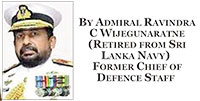
When the 1132nd RO plant built by the Navy with funds generously provided by M/S Perera and Sons, Sri Lanka’s iconic, century-old bakery and food service chain, established in 1902, known for its network of outlets, numbering 235, in Sri Lanka. This company, established in 1902 by Philanthropist K. A. Charles Perera, well known for their efforts to help the needy and humble people. Helping people gain access to drinking water is a project launched with the help of this esteemed company.
The Chronic Kidney Disease (CKD) started spreading like a wildfire mainly in North Central, North Western and Eastern provinces. Medical experts are of the view that the main cause of the disease is the use of unsafe water for drinking and cooking. The map shows how the CKD is spreading in Sri Lanka.
In 2015, when I was the Commander of the Navy, with our Research and Development Unit of SLN led by a brilliant Marine Engineer who with his expertise and innovative skills brought LTTE Sea Tigers Wing to their knees. The famous remote-controlled explosive-laden Arrow boats to fight LTTE SEA TIGER SUCIDE BOATS menace was his innovation!). Then Captain MCP Dissanayake (2015), came up with the idea of manufacturing low- cost Reverse Osmosis Water Purification Plants. The SLN Research and development team manufactured those plants at a cost of one-tenth of an imported plant.

Gaurawa Sasthrawedi Panditha Venerable Devahuwe Wimaladhamma TheroP/Saraswathi Devi Primary School, Ashokarama Maha Viharaya, Navanagara, Medirigiriya
The Navy established FIRST such plant at Kadawatha-Rambawa in Madawachiya Divisional Secretariat area, where the CKD patients were the highest. The Plant was opened on 09 December 2015, on the 65th Anniversary of SLN. It was an extremely proud achievement by SLN
First, the plants were sponsored by officers and sailors of the Sri Lanka Navy, from a Social Responsibility Fund established, with officers and sailors contributing Rs 30 each from their salaries every month. This money Rs 30 X 50,000 Naval personnel provided us sufficient funds to build one plant every month.
Observing great work done by SLN, then President Maithripala Sirisena established a Presidential Task Force on eradicating CKD and funding was no issue to the SLN. We developed a factory line at our R and D unit at Welisara and established RO plants at double-quick time. Various companies/ organisations and individuals also funded the project. Project has been on for the last ten years under six Navy Commanders after me, namely Admiral Travis Sinniah, Admiral Sirimevan Ranasinghe, Admiral Piyal de Silva, Admiral Nishantha Ulugetenna, Admiral Priyantha Perera and present Navy Commander Vice Admiral Kanchana Banagoda.
Each plant is capable of producing up to 10,000 litres of clean drinking water a day. This means a staggering 11.32 million litres of clean drinking water every day!
The map indicates the locations of these 1132 plants.
Well done, Navy!
On the occasion of its 75th Anniversary celebrations, which fell on 09 December 2025, the Navy received the biggest honour. Venerable Thero (Venerable Dewahuwe Wimalarathana Thero, Principal of Saraswathi Devi Primary Pirivena in Medirigiriya) who delivered the sermons during opening of 1132nd RO plant, said, “Ten years ago, out of 100 funerals I attended; more than 80 were of those who died of CKD! Today, thanks to the RO plants established by the Navy, including one at my temple also, hardly any death happens in our village due to CKD! Could there be a greater honour?
Features
Poltergeist of Universities Act

 The Universities Act is back in the news – this time with the present government’s attempt to reform it through a proposed amendment (November 2025) presented by the Minister of Education, Higher Education and Vocational Education, Harini Amarasuriya, who herself is a former academic and trade unionist. The first reading of the proposed amendment has already taken place with little debate and without much attention either from the public or the university community. By all counts, the parliament and powers across political divisions seem nonchalant about the relative silence in which this amendment is making its way through the process, indicative of how low higher education has fallen among its stakeholders.
The Universities Act is back in the news – this time with the present government’s attempt to reform it through a proposed amendment (November 2025) presented by the Minister of Education, Higher Education and Vocational Education, Harini Amarasuriya, who herself is a former academic and trade unionist. The first reading of the proposed amendment has already taken place with little debate and without much attention either from the public or the university community. By all counts, the parliament and powers across political divisions seem nonchalant about the relative silence in which this amendment is making its way through the process, indicative of how low higher education has fallen among its stakeholders.
The Universities Act No. 16 of 1978 under which Sri Lankan universities are managed has generated debate, though not always loud, ever since its empowerment. Increasing politicisation of decision making in and about universities due to the deterioration of the conduct of the University Grants Commission (UGC) has been a central concern of those within the university system and without. This politicisation has been particularly acute in recent decades either as a direct result of some of the provisions in the Universities Act or the problematic interpretation of these. There has never been any doubt that the Act needs serious reform – if not a complete overhaul – to make universities more open, reflective, and productive spaces while also becoming the conscience of the nation rather than timid wastelands typified by the state of some universities and some programs.
But given the Minister’s background in what is often called progressive politics in Sri Lanka, why are many colleagues in the university system, including her own former colleagues and friends, so agitated by the present proposed amendment? The anxiety expressed by academics stem from two sources. The first concern is the presentation of the proposed amendment to parliament with no prior consultative process with academics or representative bodies on its content, and the possible urgency with which it will get pushed through parliament (if a second reading takes place as per the regular procedure) in the midst of a national crisis. The second is the content itself.
Appointment of Deans
Let me take the second point first. When it comes to the selection of deans, the existing Act states that a dean will be selected from among a faculty’s own who are heads of department. The provision was crafted this way based on the logic that a serving head of department would have administrative experience and connections that would help run a faculty in an efficient manner. Irrespective of how this worked in practice, the idea behind has merit.
By contrast, the proposed amendment suggests that a dean will be elected by the faculty from among its senior professors, professors, associate professors and senior lecturers (Grade I). In other words, a person no longer needs to be a head of department to be considered for election as a dean. While in a sense, this marks a more democratised approach to the selection, it also allows people lacking in experience to be elected by manoeuvring the electoral process within faculties.
In the existing Act, this appointment is made by the vice chancellor once a dean is elected by a given faculty. In the proposed amendment, this responsibility will shift to the university’s governing council. In the existing Act, if a dean is indisposed for a number of reasons, the vice chancellor can appoint an existing head of department to act for the necessary period of time, following on the logic outlined earlier. The new amendment would empower the vice chancellor to appoint another senior professor, professor, associate professor or senior lecturer (Grade I) from the concerned faculty in an acting capacity. Again, this appears to be a positive development.
Appointing Heads of Department
Under the current Act heads of department have been appointed from among professors, associate professors, senior lecturers or lecturers appointed by the Council upon the recommendation of the vice chancellor. The proposed amendment states the head of department should be a senior professor appointed by the Council upon the recommendation of the vice chancellor, and in the absence of a senior professor, other members of the department are to be considered. In the proposed scheme, a head of department can be removed by the Council. According to the existing Act, an acting head of department appointment can be made by the vice chancellor, while the proposed amendment shifts this responsibility to the Council, based upon the recommendation of the vice chancellor.
The amendment further states that no person should be appointed as the head of the same department for more than one term unless all other eligible people have already completed their responsibilities as heads of department. This is actually a positive development given that some individuals have managed to hang on to the head of department post for years, thereby depriving opportunities to other competent colleagues to serve in the post.
Process of amending the Universities Act
The question is, if some of the contents of the proposed amendment are positive developments, as they appear to be, why are academics anxious about its passing in parliament? This brings me to my first point, that is the way in which this amendment is being rushed through by the government. This has been clearly articulated by the Arts Faculty Teachers Association of University of Colombo. In a letter to the Minister of Education dated 9 December 2025, the Association makes two points, which have merit. First, “the bill has been drafted and tabled in Parliament for first reading without a consultative process with academics in state universities, who are this bill’s main stakeholders. We note that while the academic community may agree with its contents, the process is flawed because it is undemocratic and not transparent. There has not been adequate time for deliberation and discussion of details that may make the amendment stronger, especially in the face of the disaster situation of the country.”
Second, “AFTA’s membership also questions the urgency with which the bill is tabled in Parliament, and the subsequent unethical conduct of the UGC in requesting the postponement of dean selections and heads of department appointments in state universities in expectation of the bill’s passing in Parliament.”
These are serious concerns. No one would question the fact that the Universities Act needs to be amended. However, this must necessarily be based on a comprehensive review process. The haste to change only sections pertaining to the selection of deans and heads of department is strange, to say the least, and that too in the midst of dealing with the worst natural calamity the country has faced in living memory. To compound matters, the process also has been fast-tracked thereby compromising on the time made available to academics to make their views be known.
Similarly, the issuing of a letter by the UGC freezing all appointments of deans and heads of department, even though elections and other formalities have been carried out, is a telling instance of the government’s problematic haste and patently undemocratic process. Notably, this action comes from a government whose members, including the Education Minister herself, have stood steadfastly for sensible university reforms, before coming to power. The present process is manoeuvred in such a manner, that the proposed amendment would soon become law in the way the government requires, including all future appointments being made under this new law. Hence, the attempt to halt appointments, which were already in the pipeline, in the interim period.
It is evident that rather than undertake serious university sector reforms, the government is aiming to control universities and thereby their further politicization amenable to the present dispensation. The ostensible democratis0…..ation of the qualified pool of applicants for deanships opens up the possibilities for people lacking experience, but are proximate to the present powers that be, to hold influential positions within the university. The transfer of appointing powers to the Councils indicates the same trend. After all, Councils are partly made up of outsiders to the university, and such individuals, without exception, are political appointees. The likelihood of them adhering to the interests of the government would be very similar to the manner in which some vice chancellors appointed by the President of the country feel obligated to act.
All things considered, particularly the rushed and non-transparent process adopted thus far by the government does not show sincerity towards genuine and much needed university sector reforms. By contrast, it shows a crude intent to control universities at any cost. It is extremely regrettable that the universities in general have not taken a more proactive and principled position towards the content and the process of the proposed amendment. As I have said many times before, whatever ills that have befallen universities so far is the disastrous fallout of compromises of those within made for personal gain and greed, or the abject silence and disinterest of those within. These culprits have abandoned broader institutional development. This appears to be yet another instance of that sad process.
In this context, I have admiration for my former colleagues in the Faculty of Arts at the University of Colombo for having the ethical courage to indicate clearly the fault lines of the proposed amendment and the problems of its process. What they have asked is a postponement of the process giving them time to engage. In this context, it is indeed disappointing to see the needlessly conciliatory tone of the letter to the Education Minister by the Federation of University Teachers Association dated December 5, 2025, which sends the wrong signal.
If this government still believes it is a people’s government, the least it can do is give these academics time to engage with the proposed amendment. After all, many within the academic community helped bring the government to power. If not and if this amendment is rushed through parliament in needless haste, it will create a precedent that signals the way in which the government intends to do business in the future, abusing its parliamentary majority and denting its credibility for good.
-

 Midweek Review3 days ago
Midweek Review3 days agoHow massive Akuregoda defence complex was built with proceeds from sale of Galle Face land to Shangri-La
-

 Features6 days ago
Features6 days agoWhy Sri Lanka Still Has No Doppler Radar – and Who Should Be Held Accountable
-

 News2 days ago
News2 days agoPakistan hands over 200 tonnes of humanitarian aid to Lanka
-

 News2 days ago
News2 days agoPope fires broadside: ‘The Holy See won’t be a silent bystander to the grave disparities, injustices, and fundamental human rights violations’
-

 Latest News6 days ago
Latest News6 days agoLandslide early warnings in force in the Districts of Badulla, Kandy, Kegalle, Kurunegala, Matale, Nuwara Eliya and Ratnapura
-
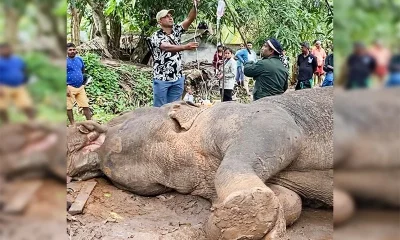
 News3 days ago
News3 days agoBurnt elephant dies after delayed rescue; activists demand arrests
-
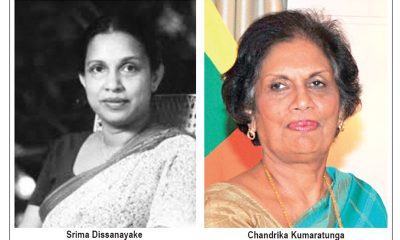
 Features6 days ago
Features6 days agoSrima Dissanayake runs for president and I get sidelined in the UNP
-

 News1 day ago
News1 day agoArmy engineers set up new Nayaru emergency bridge


